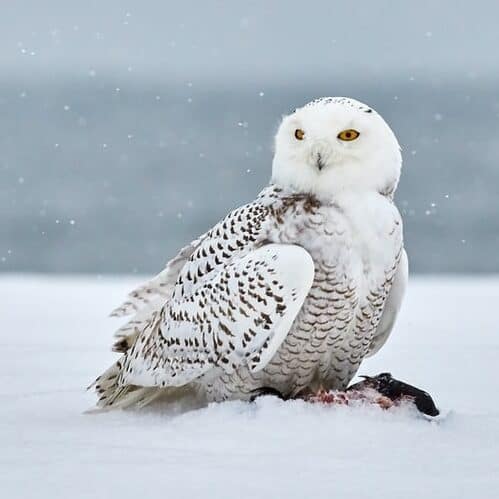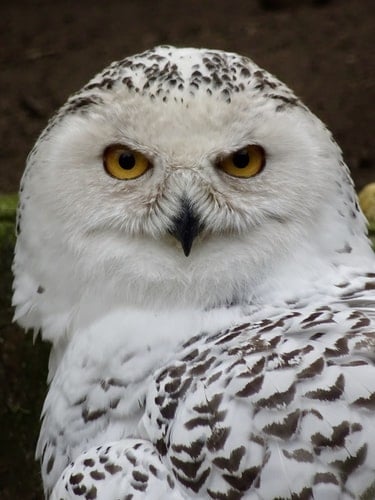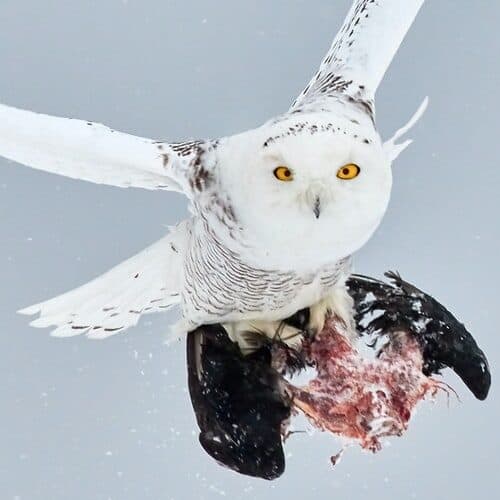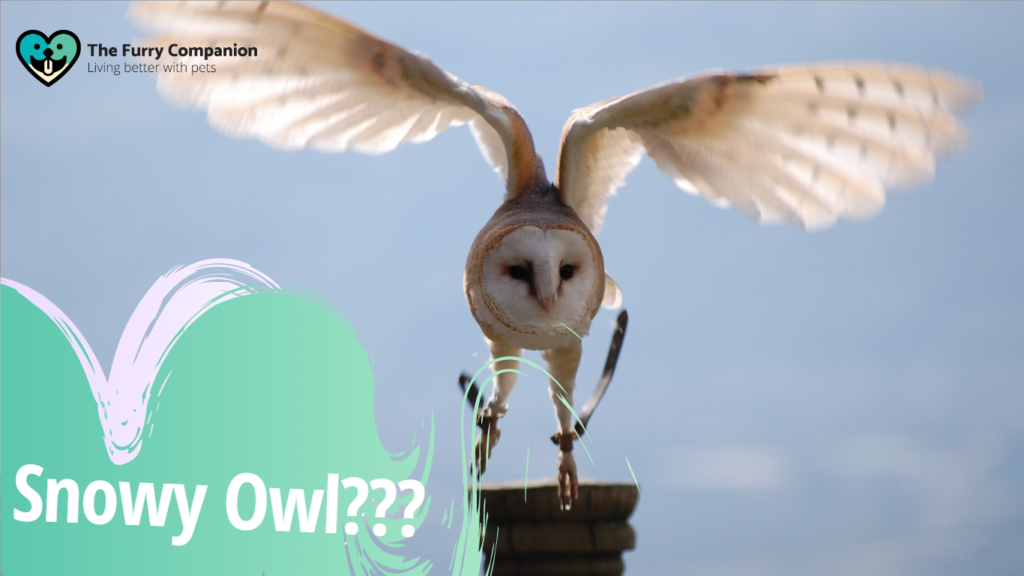All Harry Potter fans dream of owning a Hedwig even non-fans have goals of keeping their own Snowy Owl. A majestic snow-white bird to deliver to them packages and letters from anywhere and anytime. Our team from The Furry Companion, bird-watchers or not, agree that the Snowy Owl is one to behold.
Out of 225 species, it’s one of the most attention-grabbing owls soaring the sky if you’re lucky enough to spot them. With their white and dark-spotted plume, it’s an occasion when there’s a snow owl sighting during winter. Even experts who pour their energy and attention into studying these magnificent creatures can’t tell when they’ll be spotted next. Behind the miraculously white plumage, there is more beneath this owl’s piercing yellow eyes.
These white fluffy creatures may be easy on the eyes, but they are strong creatures not to be trifled by humans. If you’re looking for the ideal pet, the snowy owl may not be for you. Read on to know why it’s best not to mess with Harry Potter’s best buddy.

Table of Contents
Snowy Owl Isn’t Snow White
Even with their snow-white glow, they are far from sweet, songful, and dainty. Our immaculate feathered friend goes by Snowy Owl and Arctic Owl, and in scientific terms, Bubo scandiaca. By its name, you can already tell a list of things about it. Aside from their unmistakable white plumage, you can already tell they hail from the Arctic region. They live in the far north of the Arctic Circle during the summers.
Sometimes they might even stay the whole year in their blistering cold northern haven. Hedwig’s relatives are also known to visit Canada, North America, Europe, and Asia during the winter. They inhabit meadows, dunes, beaches, and marshes. Their sightings often depend on the lemming availability, their favorite snack.
During the nesting or breeding season, fellow Hedwigs settle on mounds in the Arctic tundras. What can we say? The cold never bothered them anyway. A female Hedwig can lay 3 to 11 eggs. We can refer to a group of lain eggs as a clutch. The size of a clutch depends on the availability of food in the area. Unfortunately, as food sources become lean, even a monogamous pair of snowy owls may not breed at all.
Picking on their family name, experts can identify they belong to the Strigidae family, opposite the Tytonidae owls. Their heart-shaped faces easily identify the latter. Owls belonging to the Strigidae side are a typical owl type. However, the snowy owl is anything but another ordinary-looking owl.

Deceiving Hoot Looks
Majestic and robust, Snowy Owls have deceivingly hoot looks. Their dense white feathers keep them warm over in the northern Arctic regions. They are one of the heaviest in North America with weight ranging between 1.5 to 6.5 lbs. Don’t be confused that a 20-inch bird is massive. According to experts, their dense mass is a result of heavy feathers on its body. These white majestic creatures may not look so intimidating beside an adult human.
However, as they expel intimidation and awe with their 4.2 to 4.8 feet wingspan, talk about range! They are also one of the giant owls you may find in North America. In size, owlets outsize their male counterparts. On average, they often grow up to 20 – 28 inches. Female owls are more massive, but they carry themselves with such confidence in their plume.
Snowy Owls are a vision in white, but they may not look like that when they hatch. Truthfully, they don’t look as im-peck-able as baby owls, so it’s true what they say – “beauty comes with age.” Instead of white fluff balls, snowy baby owls have dark feathers, and as they grow older, these feathers turn whiter.
Their females usually display more dark flecks scattered around their body compared to males. Ladybirds of this species have a crown of dark markings on their heads. On the other hand, a male snowy owl may turn wholly white but retain a few dark plumages. We’ve mentioned that they have unmistakable bright yellow eyes atop their black beaks.
Snowy owls may carry virus that can cause diseases such as Herpesvirus. According to Michael Jones, DVM, DABVP, “This disease as been reported as a naturally occuring infection in the great horned owl (Bubo virginianus) and snowy owl (Nyctea scandiaca).”
A Snowy Owl and It’s Cold Affection
It may come to a surprise to some of you readers, but owls are solitary creatures. As pets, they’re not so affectionate towards their human companions, unlike other types of birds, or pets, for that matter. In terms of showing affection to their mate, an Arctic owl’s love is as cold as, well, the Arctic.
However, snowy owls are very traditional. They follow this mating ritual. The male owl flies in smooth rising and falling form flapping his wings in an exaggerated beat to attract the lady. He further attracts the female owl by offering a lemming he holds by the talons or beak. Descending to the ground with wings in a “V” form, he drops his offering, confidently lands, and stands erect. He then fans his tail, awaiting the approach of his lady friend. Affection only lives through the courting phase for these cream-colored wise birds. And that’s about it for this Snow White’s romance.
These white owls are also very territorial creatures. They will not hesitate to protect their nest and fledglings against a more significant mammal. Stories circulate that snowy owls can knock down a human with a swift swoop. Check this owl-inspired blanket to pair up with your pet.

An Independent and Free Disposition
Choosing an independent pet like a snowy owl is just plain ironic. They are independent by nature, and if they could screech at you, they’d say they were comfortable that way. If you don’t believe us, here are some truth bombs about their independent disposition.
“Snowy owls are frequently kept in captivity in more temperate climates where the higher temperature most of the year may predispose these birds to multiple health issues,” Hugues Beaufrère, DVM and co-author mentioned.
They are one of the very few owl species to build their nests. Experts believe male snowy owls choose the territory, and his partner selects wherein the area is the nest site. The female snowy owl scratches a shallow bowl on the ground on top of a hill. She then shapes it by pushing her body into a depression until it cups her body snuggly. This process of imprinting a nest takes a few days to accomplish. When they leave the nest, another pair can move in their little hole in the ground.
The female lays the eggs asynchronously one every two to three days. Even as babies, these owls are strong and independent. Later on, fledglings leave their nest and spend a month hiding and taking baby steps around the tundra before flying. You can buy this bird cage for your owl.
On the other hand, if you’ve gotten permits to take care of a fledgling, it imprints on the humans feeding it. This bonding experience might be precious in the beginning, but come the owl’s sexual maturation, it thinks differently. It usually will regard its owner as a mate or threat. Either way, they can get very territorial. As an owner, you might be on the guarded end of your protective snowy security. But you also have high chances of being attacked by your pet owl.
They are incredibly self-sufficient, and they love their freedom. Non-domesticated snowy owls don’t need ownership or caretakers. Snowy Owls have daytime habits. Unlike other owls, they are not nocturnal. Instead, they choose the long hours of the day to hunt. The Arctic’s long summer days and zero hours of the night may give rise to this peculiar habit.
However, experts have found they also take chances in hunting during the nighttime. As prospective feathered mothers, their practices may take time to observe and track. They can be very unpredictable, and they’re probably doing in on purpose. At least you can agree when bedtime is for them, most of the time.
Dwindling Flock of Snowy Owls
Snowy owls don’t flock together. But an essential factor to consider before ruffling their feathers is their dwindling population. A study conducted by the International Union for Conservation of Nature (IUCN) releases the status of this type of owl as “vulnerable.” The adult population of snowy owls from 200,000 in 2013 decreased to 28,000 in December 2017. Any further disappearance of Hedwigs pushes them further up along the endangered list.
Their population decline is a result of both human and environmental factors. The former captures their population with egotistic sport and trophy status. On the other hand, global climate change, which may still be due to humans, affects their natural habitat.
Snowy Owls Are High-Maintenance
For your reference, we will give you a brief snapshot of your duties as a Snowy Owl’s servant. These white king owls are like hooting royalty in the bird kingdom. These majestic creatures expect the best diet and treatment as their minimum lifestyle.
- Owl Chow
Their primary diet comprises small mammals like rodents and little rabbits or hares. They also develop cravings for other small songbirds to medium-sized geese. On the side, they may gobble up insects and plants, if they feel like it. However, their ultimate favorite dish is lemmings with three to five servings each day. If you have rodents and lemming-like pets around the house, it’s best to keep them away from each other.
According to Sonia M. Hernandez, DVM, PhD, DACZM, “Birds of prey all have: hooked beaks, talons, are either predators or scavengers.”
If you think you’ve got what it takes to host a snowy owl, you need to prepare their usual prey. You would need a supply of frozen and thawed rats, mice, and chicks. They prefer to feed on these treats whole. If you want to make a good impression, you would hunt for them and serve these dishes alive. Snowy owls love a good hunt before dinner. They have this distinguishable technique of swooping in to snatch prey by their terrifying talons. It is called wallop.
- Snowy Exercise
All pets need to stay in tip-top shape. A snowy owl in captivity is no different. Owners need to take them out of their holding cages for a quick flight around the park. Parenting feathered creatures need the expert skills of falconry. In some countries, you have to apply for a license. Falconry equipment needs to be made of quality materials too. Your snowy owl needs a specialized hood to keep them calm during training. Meanwhile, the trainer needs to invest in gloves to keep them safe also.
And that ends our six top reasons why Snowy Owls do not need to be held captive. The least we could do for these beautiful, cool-headed birds is protect them even if it means admiring them from afar. Their captivating aura is a sight to behold. However, as their numbers decrease each day because of human interactions, we should reflect on our acts. How better can we serve these independent creatures? At this population, Snowy Owls are already a rare sight. What more should we continue to hunt them and destroy their homes? It would be a Snowy Owl miracle to see them over the winter.
Frequently Asked Questions
What is a snowy owl’s habitat?
Snowy owls live in the Arctic. They are frequently in treeless and open areas, which are called tundra. Snowy owls watch their prey through perching on short posts or the ground. Typically, they hunt down lemmings, but they also go for other animals such as rodents, fish, rabbits, and birds.
What color are snowy owls?
As the name suggests, snowy owls are white. They have brown and black markings on their wings and body. Female snowy owls have noticeably more markings, which gives them the salt and pepper look. Meanwhile, males look generally paler, and they tend to go whiter as they grow old.
What do snowy owls do in the winter?
While snowy owls like to stay in the Arctic during summer, they move to the south during the winter. They usually go to places that are covered in snow so that they can easily blend in. Snowy owls frequently prefer marshes, dunes, and farmlands, or any open and flat areas. For as long as there are preys in the area, it will undoubtedly be an excellent place to stay for them.
What is the predator of a snowy owl?
Snowy owls do not have as many predators. Often, only wolves and foxes hunt them down when they are vulnerably near their nest or sitting on it. Once in a while, gulls may also attempt to get young owls or eggs from the nest.
What is a white owl called?
White owls are often called snowy owls. They originate from the true owl family. Sometimes snowy owls are also called white owl, Arctic owl, or polar owl.
Why do snowy owls have yellow eyes?
Owls’ eye colors are different, and it typically specifies the time of day that they prefer to hunt. A snowy owls’ yellow eyes indicate that they diurnal, which means that they like to hunt during the day. It also means that they are active in the day while they sleep during the night.
Do snowy owls change color in the summer?
While other animals such as snowshoe hares and Arctic foxes change color, snow owls don’t. Snowy owls are white all year round, and so they stay white even in the summer.
Are snowy owls birds of prey?
Yes, snowy owls are birds of prey. They have excellent eyesight and superb hearing capacity, which helps them identify targets even in thick snow cover. Before they attack their game, they first identify it from afar by patiently perching.
What are the common health problems of snowy owls?
Since the Snowy Owl originates from the arctic and subarctic regions, it can be more susceptible to fungal infection when domesticated in a warmer and drier environment. Aspergillosis can cause respiratory problems which may result in depression or loss of appetite.
Is owning a Snowy Owl illegal?
While it is legal for various owls to be owned in the U.K., it is not legal in the U.S. to purchase a Snowy Owl. You can either sponsor owls living in the sanctuary or an animal shelter.

